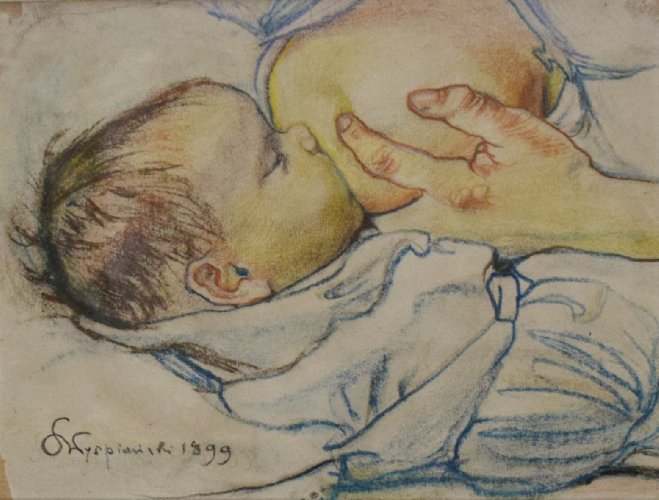Description:
Stanisław Wyspiański (1869-1907) had a large influence on the shaping of his original and recognizable style, thanks to his studies with Jan Matejko in Krakow, his travels, and his several years spent in Paris with his friend Józef Mehoffer. He was particularly impressed by the works of Van Gogh, Gauguin and Toulouse-Lautrec, which he encountered there. Sensitive to oil paint, he began to mainly use pastels. In addition to painting, he was also involved in graphic art, decorated polychromes, designed stained glass, theatrical sets, interiors and furniture, wrote poetry and dramas. His art, which fits into the program of Young Poland, is described as symbolic, expressionist and secessionist.
Description of the painting:
The frame narrowed by the artist shows what is most important, the very essence of motherhood. The scene is very intimate, private and personal. The sketchy character and small size of the composition may suggest that it was created under the influence of the moment of admiration for the beauty of this simple act. The child is presented as defenseless, fragile and dependent on the mother. The last one is symbolized on the small sketch by a generous breast and a supporting, toiled hand. The central motif of feeding is decorated with linearly marked folds of pillows, baby blankets and the mother’s open shirt.
The child has half-closed, probably still weakly seeing eyes, with sparse tufts of tousled, dark hair on the head. It seems to be calm and safe. It almost merges with the mother’s breast. This symbiosis is especially visible in the color scheme. Yellow glows fall on the roundness of the mother’s breast and the full cheeks of the child, both delicately shaded with brown and red crayons. Each line finds its natural place, drawn flawlessly and decisively, and yet, as if with tenderness. Wyspiański often portrayed the images of his closest. From getting to know Teodora Teofila Pytko from the village of Konary near Tarnów, among the great projects there are also intimate images of her feeding. Over time, Wyspiański began to capture images of his own children, already without the mother’s arms, usually in pastel on paper. Dozens of paintings look at sleepy, bored, and even glum kids, painted with fatherly sensitivity and tenderness.
In 1899, on September 7, Mieczysław Bolesław was born. So we can almost be sure that it is he who is portrayed in the painting from this year. Only after his birth did Stanisław Wyspiański decide to take a quiet wedding with Teodora, which was an obvious misalliance. In 1901 their second son, Stanisław, was born. The family never accepted Teodora, writing about her very unfavorably in letters. It is difficult to conclusively judge today whether Wyspiański loved her or married her only out of a sense of duty. However, from the pictures it is certain that he had an immense love for his children.


